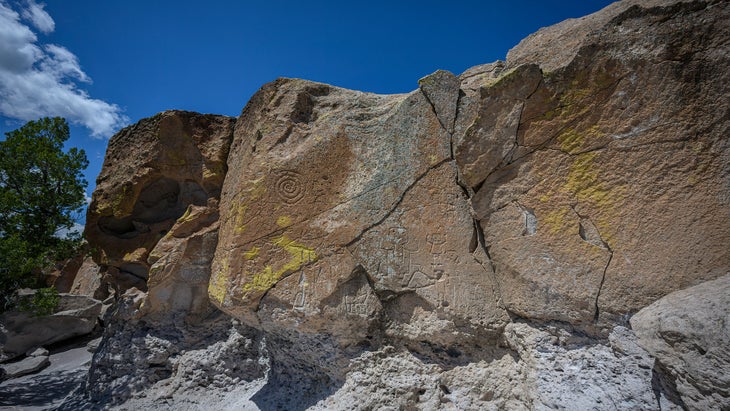Products You May Like
Get full access to Outside Learn, our online education hub featuring in-depth fitness, nutrition, and adventure courses and more than 2,000 instructional videos when you sign up for Outside+
Sign up for Outside+ today.
As my husband, daughters, son, au pair, and I took hold of the grips carved into the soft sandstone of the Tsankawi Trail near Bandelier National Monument in New Mexico, we were following footsteps and handholds that Native ancestors had planted here 700 years before.
With every step, orange desert dust settled on our pants, our shoes, and under our fingernails. It was a cloudless bluebird day. While we walked, we listened attentively as our guides, Elmer and Deborah Torres of Passport to Pueblo Country, interpreted what we were seeing. There were the circular homes and kivas built into the sides of the rocks, facing the sun to keep them warm in the colder days. The people who lived there tended gardens and used the expansive views from the mesa top to see incoming people, game, and weather. Even the path we followed was centuries old.
We could have done the trail solo, but had opted to go along with the Torreses, members of San Ildefonso Pueblo, instead. My children, ages 13, 9, and 5 at the time, love history and stories. We were visiting the Santa Fe, New Mexico, area for my work as an influencer and plus-size brand advisor. Hiking for me is about breaking down barriers between folks. I figured my family could use some of that as well.
“Good morning, Sen geh Tah Muu,” Elmer said when we first met. He introduced himself with his Tewa name, Po qwen tsa, which means White Water Lake. Deborah is called Than Povi (Sun Flower) and Po la mimi Povi (Butterfly Flower).
Elmer and Deborah started their business by offering tours and meals in their pueblo. Breaking bread, they found, was a fine form of sharing cultural traditions. That ended with the arrival of the pandemic, which closed the Pueblo to outsiders. Instead, they began to break trail.

Elmer explained that years of footprints carved the paths—many now knee-deep—into the mountain. The ladders are new, of course, and they lead to where the Puebloans built their original community between the 1100s and 1200s or even before. He showed us the sundials atop the mesa, petroglyphs in the walls around us: art, but also a message for anyone who happens upon it with echoes of their daily life, of the deer and elk they hunted and birds and lizards that skittered around them.
“You are walking through a museum,” he told us, a reminder to take only photos and leave only footprints.
We came upon a prickly pear cactus. “This could be food, sandals, and rope,” he explained. The cactus that speckled the mesa took on a new life before our eyes.
According to Elmer, the couple’s tours aren’t just a way to occupy a few hours. He hopes that guests come away from them with a new awareness of the culture his ancestors passed on to him, which has been thriving in his homeland for centuries.
“My stories are based on written and oral history,” he said. Sharing them is a way to ensure they are passed on. “We always pray to them that they take care of us. To our ancestors, the spirits that have gone before us. We give them thanks for everything we have to this day.”
Back on the mesa, my son peeked his head out of a kiva, the same place scores of Ancestral Puebloan people used to keep warm in the sun. His smile glowed as a ray of light graced his face. The hike to this point hadn’t been the hardest we had ever done, but thanks to Elmer and Deborah, it had been one of the deepest. It had helped us understand that when we hiked, the experience wasn’t just about us, it was about all those who set the path before us. It had helped us, too, to grasp our responsibility to keep learning about the real human history of the trails we walked.
“You’ll find a different experience coming with a tribal member,” Elmer said. “We go beyond what’s in the textbooks. You learn about the history, how they utilized land in the early days, how they survived, and made it better for every one of us. Now it is our turn to leave some kind of legacy for someone as well.”
